
Great businesses endure by mastering the fundamentals.
Congratulations on taking your first step! By your involvement, we assume that you lead or help to lead a U.S. business or non-profit organization. On behalf of our entire team here at The Executives Institute, let us say “Thank you!” for everything that you do for our great nation.
Below are 50 fundamental business Rules, sourced from 50 timeless business books, divided into 12 Chapters.
Each Chapter and each Rule are designed as a stand-alone study. Begin any time you like. While the 12 Chapters form a complete leadership curriculum, they do not need to be attended in sequence.
Week 1 begins now.
Chapter 1: Foundations First
WEEK 1 | Rule No. 1 —Solve a real problem.
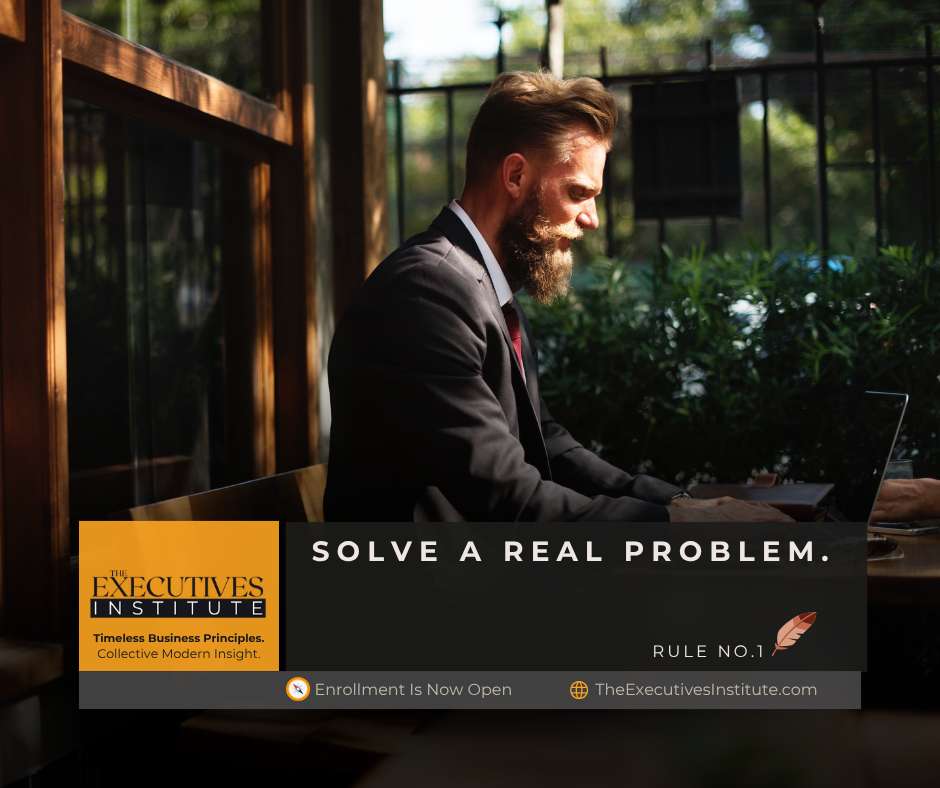
RULE NO. 1 SUMMARY ![]()
If your product, service or strategy isn’t solving a real problem for a real person, it’s a vanity project – not a business.
Painkillers outperform vitamins every time.
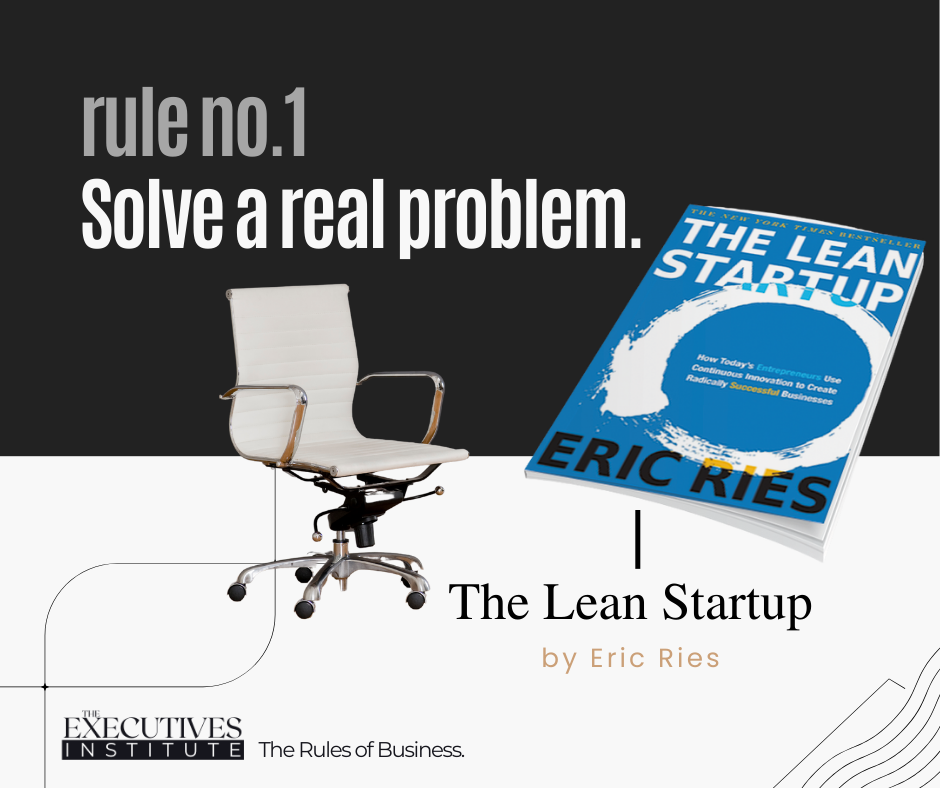
RECOMMENDED READING: The Lean Startup, by Eric Ries
Ask Yourself: What problem does our business truly solve—and would our customers describe it the same way?
This week’s Action Step —
Interview three existing or potential customers to uncover a problem they’re actively trying to solve. Document exactly how they describe it in their own words.
Now, write down your core problem statement—not in your words, but in your customer’s words.
WEEK 2 | Rule No. 2 —Fall in love with the problem, not the solution.
RULE NO. 2 SUMMARY ![]()
Solutions come and go, but a deep understanding of the real problem creates lasting value. Focus on the true needs and challenges of your customers—not your preconceived ideas.

RECOMMENDED READING: The Mom Test, by Rob Fitzpatrick
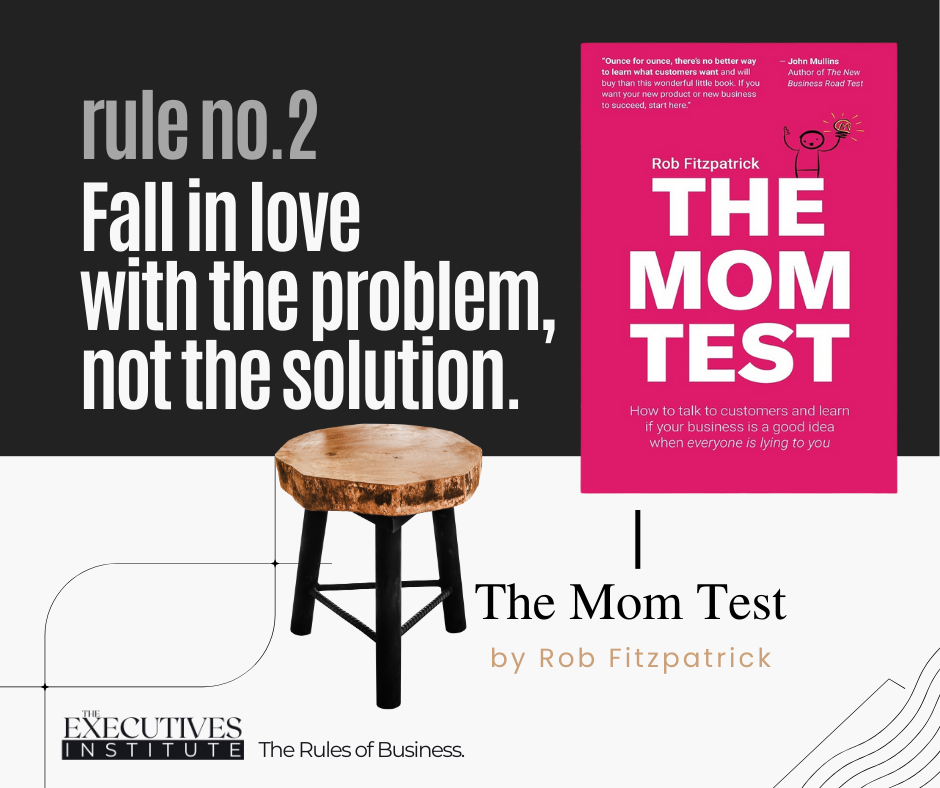
Ask Yourself: Are you defending your solution…or solving the customer’s real need?
When was the last time you deeply re-examined your customers’ pain points without trying to sell them your solution?
This week’s Action Step —
Commit to having two customer or prospect conversations. Don’t pitch—just ask questions. Then, list three ways your current solution could fail, and rethink from the problem backward.
WEEK 3 | Rule No. 6 —You’re first idea is rarely your best.

RULE NO. 6 SUMMARY ![]()
Great ideas emerge after rethinking and refining initial concepts, proving that persistence and revision often lead to better solutions. The most original thinkers don’t settle for their first solution—they generate many. Great ideas often emerge later in the creative process, after initial concepts have been tested, challenged, or discarded. Quantity breeds quality when you’re willing to rethink, revise, and persist beyond what’s obvious.
RECOMMENDED READING: Originals, by Adam Grant
Plus, this week’s —
Action Step: Come up with three new variations on a current project before finalizing your plan.
Ask Yourself: If you couldn’t use your current approach, what would you do instead?
WEEK 4 | Rule No. 10 —Never stop learning.

RULE NO. 10 SUMMARY ![]()
A growth-minded leader embraces learning as a lifelong process—not a phase to graduate from. Whether you’re in the boardroom or the breakroom, staying open to new ideas, skills, and feedback separates those who evolve from those who become irrelevant.
RECOMMENDED READING: Mindset by Carol Dweck
Plus, this week’s —
Action Step: Identify one skill, concept, or perspective outside your current expertise that could materially improve your business or leadership impact. Schedule 60 minutes this week to actively explore it—through reading, a podcast, a course, or a conversation with someone knowledgeable—and capture one actionable insight you can apply immediately.
Ask Yourself: Where am I relying on what I already know instead of seeking what I need to learn to grow myself and my business?
WEEK 5 | RULE NO. 15 —Work on your business, not just in it.

RULE NO. 15 SUMMARY ![]()
Successful businesses aren’t built by overworked operators—they’re built by owners who step back, see the big picture, and design systems that scale. This rule is a wake-up call: if you’re stuck doing all the work yourself, you’re not building a business—you’ve just bought yourself a job. Working on the business means shifting from technician to architect, from doing the tasks to designing the machine that gets them done.
RECOMMENDED READING: The E-Myth Revisited by Michael Gerber
Plus, this week’s —
Action Step: Block two hours this week for strategic planning, not daily operations.
Ask Yourself: What’s the one improvement that would make your work easier next month?
Before we move on, you may be asking,
“Why do some of the Rules seem so similar?”
You may notice that a few rules touch on related ideas. That’s intentional. Business success rarely comes from isolated actions—most powerful principles apply in multiple ways. Overlapping rules show how a single behavior or mindset can influence different areas of your company, your team, and your decisions. Seeing the same idea from multiple angles helps reinforce it, making it easier to act on consistently.
Chapter 2: Know Your Customer
WEEK 6 | Rule No. 11 —Your brand is your promise.

RULE NO. 11 SUMMARY ![]()
Your brand isn’t your logo or slogan—it’s the consistent promise you make and keep to your customers, shaping what they expect from every experience with your business. Your brand is the unspoken contract you sign with the world—break it, and you’re just another company people stop trusting.
RECOMMENDED READING: Building Strong Brands by David A. Aaker
Plus, this week’s —
Action Step: Review your website and sales material to ensure they reflect your core promise.
Ask Yourself: Does every customer interaction strengthen—or weaken—trust in that promise?
WEEK 7 | Rule No. 12 —Know your customer deeply.

RULE NO. 12 SUMMARY ![]()
Success doesn’t come from serving the average — it comes from understanding the specific. When you know your customer deeply, you stop guessing and start delivering. This rule demands more than surface-level data; it requires insight into your customer’s motivations, frustrations, values, and unmet needs — the things they might not even articulate themselves. Businesses that take the time to know their customers at this level earn loyalty, trust, and relevance in a way competitors can’t replicate.
RECOMMENDED READING: Know Your Customer by Robert Woodruff
Plus, this week’s —
Action Step: Call a customer and ask what nearly stopped them from buying from you.
Ask Yourself: How much of your customer’s daily reality do you truly understand?
WEEK 8 | Rule No. 18 —Your calendar reflects your priorities.

RULE NO. 18 SUMMARY ![]()
If you want to know what truly matters to a person, don’t ask them—look at their calendar. This rule confronts the lie we tell ourselves that “we didn’t have time,” when in reality, we simply didn’t make it a priority. Time is the most democratic resource—everyone gets 24 hours. High performers don’t find more time; they allocate it better. They schedule their values. They protect their most important goals from being swallowed by the urgent but unimportant. Covey called this “putting first things first”—and it’s the difference between being busy and being effective.
RECOMMENDED READING: The 7 Habits of Highly Effective People by Stephen R. Covey
Plus, this week’s —
Action Step: Review next week’s schedule and remove anything not tied to top priorities.
Ask Yourself: Would a stranger know your priorities by looking at your calendar?
WEEK 9 | Rule No. 21 —Clarity creates confidence.

RULE NO. 21 SUMMARY ![]()
When leaders communicate with precision, people know where they’re going—and why it matters. Clarity cuts through noise, eliminates confusion, and drives focused action. In business, vague messaging leads to hesitation, misalignment, and wasted effort. But when your ideas are simple, specific, and sticky, teams gain the confidence to move fast and move together.
RECOMMENDED READING: Made to Stick by Chip Heath & Dan Heath
Plus, this week’s —
Action Step: Choose one message you’re responsible for this week—a team update, customer email, or board report. Strip it down to the single most important point you want remembered. Deliver it with plain, direct language. Then, ask someone outside the room to repeat it back—if they can’t, you haven’t been clear enough.
Ask Yourself: If I weren’t in the room to explain this further, would my team (or customer) still understand exactly what I mean—and what to do next?
Chapter 3: Hiring Without Regret
WEEK 10 | Rule No. 22 —Hire slow, fire fast.

RULE NO. 22 SUMMARY ![]()
The strength of your team determines the strength of your business. Hiring slow means committing to a disciplined process—one that prioritizes fit, capability, and character over speed or convenience. It means refusing to lower the bar just to fill a seat. Firing fast means addressing misalignment or underperformance decisively before it corrodes culture, morale, or momentum. Tolerating the wrong hire too long is more costly than taking the time to hire the right one.
Right people, right roles, right now—or nothing.
RECOMMENDED READING: Who by Geoff Smart & Randy Street
Plus, this week’s —
Action Step: Before your next hire, create a one-page Hiring Scorecard that defines exactly what success looks like in the role—skills, cultural fit, and measurable outcomes. Share it with your leadership team and commit to not making an offer until a candidate meets the majority of those standards. This forces clarity and slows down impulse hiring.
Ask Yourself: Am I keeping someone on the team right now who I already know doesn’t belong here—and if so, what’s stopping me from making the call?
WEEK 11 | RULE NO. 24 —Own your mistakes.

RULE NO. 24 SUMMARY ![]()
Great leaders don’t deflect blame — they absorb it, learn from it, and lead forward. Owning your mistakes isn’t weakness; it’s the foundation of credibility, respect, and real accountability. In any failure, you either make excuses or you make progress — never both.
RECOMMENDED READING: Extreme Ownership by Jocko Willink & Leif Babin
Plus, this week’s —
Action Step: This week, identify one mistake from the past 30 days that you’ve downplayed, justified, or quietly ignored. Share it openly with your team or a trusted colleague. Explain what you learned and how you’ll prevent it in the future. The goal isn’t to dwell — it’s to model accountability and set the standard for ownership.
Ask Yourself: If my team copied the way I handle mistakes, would we be stronger — or weaker — as an organization?
WEEK 12 | RULE NO. 31 —Delegate outcomes, not tasks.
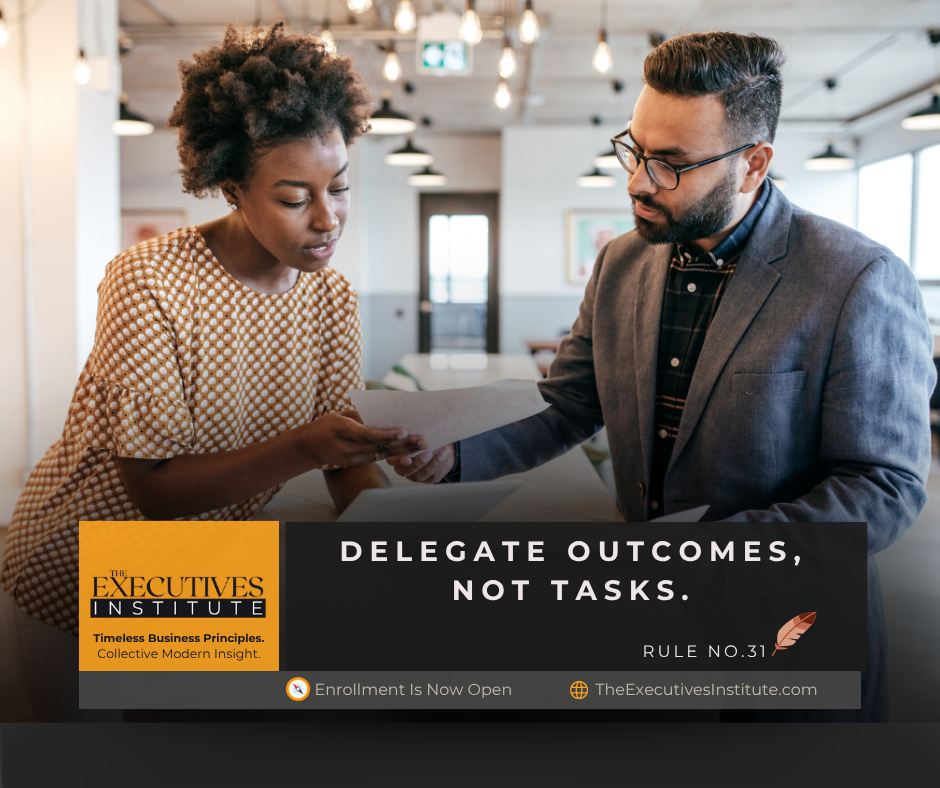
RULE NO. 31 SUMMARY ![]()
Don’t just assign to-dos—transfer responsibility. When you delegate outcomes instead of tasks, you empower people to think, act, and lead with ownership. It’s the difference between creating followers and developing leaders.
RECOMMENDED READING: Turn the Ship Around! by L. David Marquet
Plus, this week’s —
Action Step: This week, pick one project or responsibility you normally delegate as a set of tasks. Instead, delegate only the desired outcome. Be explicit about what success looks like, the non-negotiables, and where they have freedom to decide. Then step back—resist the urge to dictate the how—and watch how your team handles the ownership.
Ask Yourself: Am I giving people responsibility for results, or just instructions for work?
If your team consistently comes back to you for the next step, chances are you’re still delegating tasks. If they come back with solutions, you’re delegating outcomes.
WEEK 13 | RULE NO. 49 —People over processes.

RULE NO. 49 SUMMARY ![]()
Processes are important. But people drive results. Over-relying on systems, procedures, and checklists at the expense of human judgment, initiative, and ownership is a slow march to mediocrity. Organizations thrive when they trust and invest in people—not just when they refine processes. Processes should serve people, not control them.
RECOMMENDED READING: The Human Side of Enterprise by Douglas McGregor
Plus, this week’s —
Action Step: This week, identify one process, policy, or system in your organization that frustrates your best people more than it helps them. Eliminate it, simplify it, or delegate authority so decisions can be made without it. Show your team that trust trumps bureaucracy.
Ask Yourself: If I truly trusted my people, what process would I no longer need?
Chapter 4: Strategy in the Real World
WEEK 14 | RULE NO. 3 —Differentiate or Die.

RULE NO. 3 SUMMARY

If your business blends in, it’s already falling behind. In crowded markets, blending in is a slow death. The only way to lead—not just survive—is to break away from the pack by creating clear, compelling differentiation.
RECOMMENDED READING: Blue Ocean Strategy by W. Chan Kim & Renée Mauborgne
Plus, this week’s —
Action Step: Ask five of your best customers why they chose you—and what they believe you do better than anyone else. Compare their answers with your own team’s assumptions. If the gap is wide, your differentiation is weaker than you think.
Ask Yourself: If we stripped away our logo and brand name, would our products, services, or customer experience still make us unmistakably recognizable?
WEEK 15 | RULE NO. 4 —Play the long game.
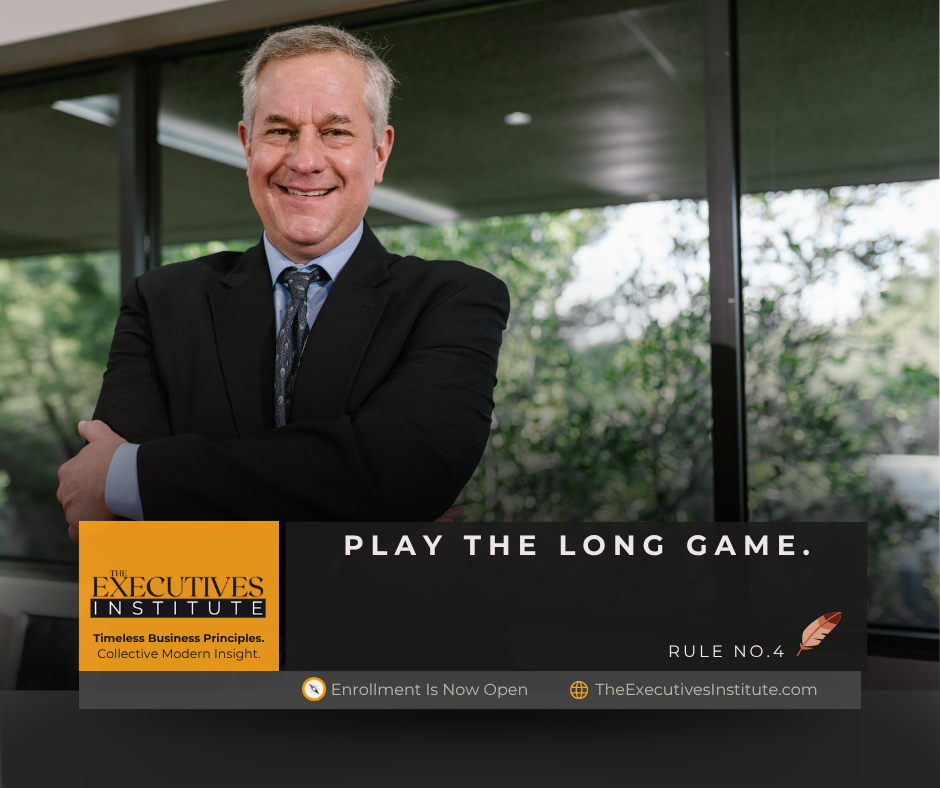
RULE NO. 4 SUMMARY![]()
Success in business isn’t about winning — it’s about enduring. Prioritize long-term vision, trust, and adaptability over short-term gains. Great companies focus on building something that lasts, not just something that performs today.
RECOMMENDED READING: The Infinite Game by Simon Sinek
Plus, this week’s —
Action Step: Identify one current decision or project where short-term results are driving your choices. Reframe it with a 5–10 year perspective: What action today would strengthen the organization’s future, even if it costs more now? Commit to taking that long-term step this week.
Ask Yourself: Am I building for today’s approval — or tomorrow’s endurance?
WEEK 16 | RULE NO. 5 —Make fewer, bolder moves.

RULE NO. 5 SUMMARY ![]()
Focus beats frenzy. Spread too thin, you risk mediocrity everywhere. Bold, deliberate moves—rooted in strategy, not reaction—create real advantage. Commit to fewer initiatives, but back them fully. Win where it matters.
RECOMMENDED READING: Playing to Win by A.G. Lafley & Roger Martin
Plus, this week’s —
Action Step: Review your top five current initiatives. Cut the list to the one or two that, if successful, would make the biggest impact. Redirect time, budget, and people to those—and pause or kill the rest.
Ask Yourself: If we stopped everything else and went all-in on this one move, would it truly change the trajectory of our business?
WEEK 17 | RULE NO. 25 —Ask better questions.

RULE NO. 25 SUMMARY![]()
The quality of your outcomes is directly tied to the quality of your questions. Leaders who ask better questions don’t just get better answers—they uncover blind spots, surface assumptions, and spark clearer thinking in themselves and others.
RECOMMENDED READING: A More Beautiful Question by Warren Berger
Plus, this week’s —
Action Step: In your next leadership meeting, replace one agenda item with a single, open-ended question. Don’t answer it immediately—let the group wrestle with it. Measure the quality of the conversation, not the speed of the conclusion.
Ask Yourself: Am I leading my team toward better answers—or am I limiting them by asking small, safe questions?
WEEK 18 | RULE NO. 26 —Define it. Measure it. Achieve it.

RULE NO. 26 SUMMARY ![]()
Vague goals don’t move organizations forward—clear objectives do. This rule reminds executives that without defining what success looks like and establishing the right metrics, progress is merely hope in disguise. Define the outcome. Tie it to measurable key results. Then hold the line until it’s achieved.
RECOMMENDED READING: Measure What Matters by John Doerr
Plus, this week’s —
Action Step: This week, pick one major goal your team is working on. Rewrite it into a single, clear objective with no more than 3 measurable key results. Share it with your team and confirm everyone understands both the objective and how progress will be tracked.
Ask Yourself: Do I know—today—whether we’re winning or losing on our top priorities? Or am I relying on gut feel instead of measurable progress?
Chapter 5: Execution Beats Ideas
WEEK 19 | RULE NO. 7 —Momentum beats motivation.

RULE NO. 7 SUMMARY ![]()
Don’t wait to feel inspired. Show up, act anyway, and let discipline build momentum. Waiting to feel inspired is a trap. Progress happens when you show up consistently—especially when you don’t feel like it. Motivation is fleeting; momentum is earned.
RECOMMENDED READING: The War of Art by Steven Pressfield
Plus, this week’s —
Action Step: Commit to one “non-negotiable” action every day this week, no matter how small, that moves a key business initiative forward. Record it, track it, and repeat—even if motivation is low. The goal is consistent motion, not perfect execution.
Ask Yourself: Where in my work am I waiting to feel motivated, when I could instead create momentum by taking consistent action?
WEEK 20 | RULE NO. 8 —Don’t mistake movement for progress.
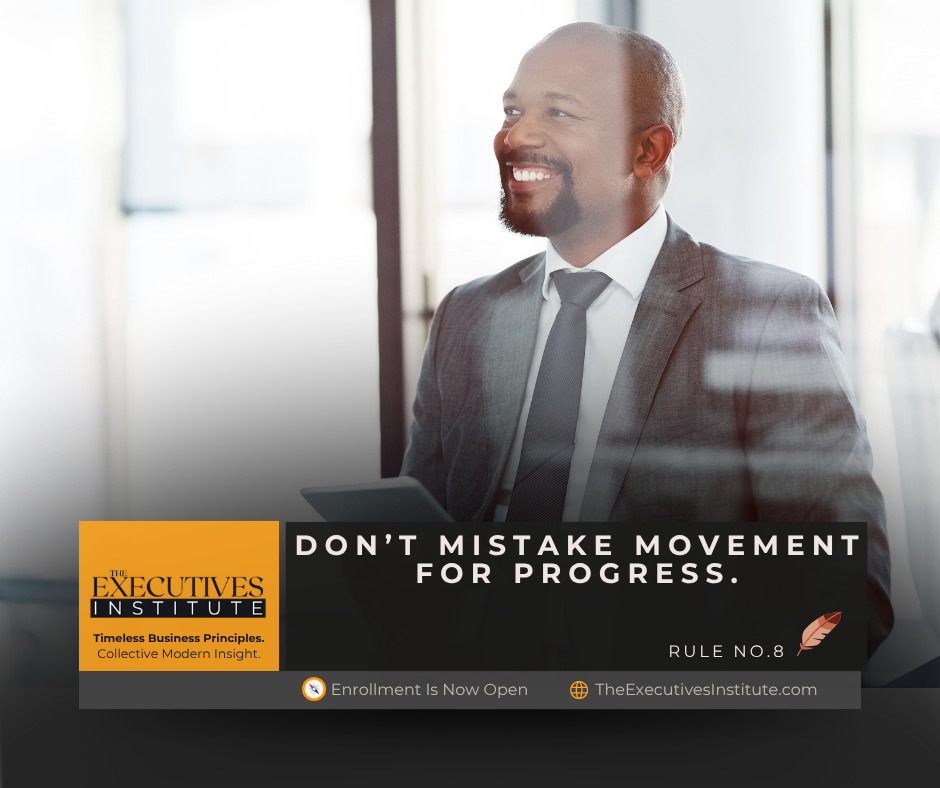
RULE NO. 8 SUMMARY ![]()
It’s easy to confuse being busy with being effective. But motion without direction isn’t progress—it’s distraction in disguise. This rule reminds us that true advancement comes not from activity, but from purposeful, disciplined action.
RECOMMENDED READING: Essentialism by Greg McKeown
Plus, this week’s —
Action Step: Audit Your Activity: For one full day this week, track every task, meeting, and email. At the end of the day, categorize each item: essential, optional, or distracting. Identify at least one activity to eliminate or delegate, and commit to focusing on the tasks that truly drive progress.
Ask Yourself: Am I spending more time in motion than on meaningful outcomes? Which one change this week would create the biggest forward movement in my work or team?
WEEK 21 | RULE NO. 9 —Focus beats multitasking.

RULE NO. 9 SUMMARY

Multitasking is a myth. Every time you split your attention, you dilute your effectiveness. This rule reminds us that meaningful progress doesn’t come from doing more things—it comes from doing the right thing with undivided attention.
RECOMMENDED READING: The One Thing by Gary Keller & Jay Papasan
Plus, this week’s —
Action Step: Identify your “One Thing” for the week.
- At the start of the week, list all key tasks and choose the single most important action that will drive the biggest results.
- Block uninterrupted time on your calendar to work exclusively on that task—no emails, calls, or side projects allowed during this window.
- Track progress daily, and review at week’s end: did focusing on one thing move the needle?
Ask Yourself: Am I spending my time on the task that truly matters, or am I confusing activity with progress?
WEEK 22 | RULE NO. 27 —Do the hard things first.
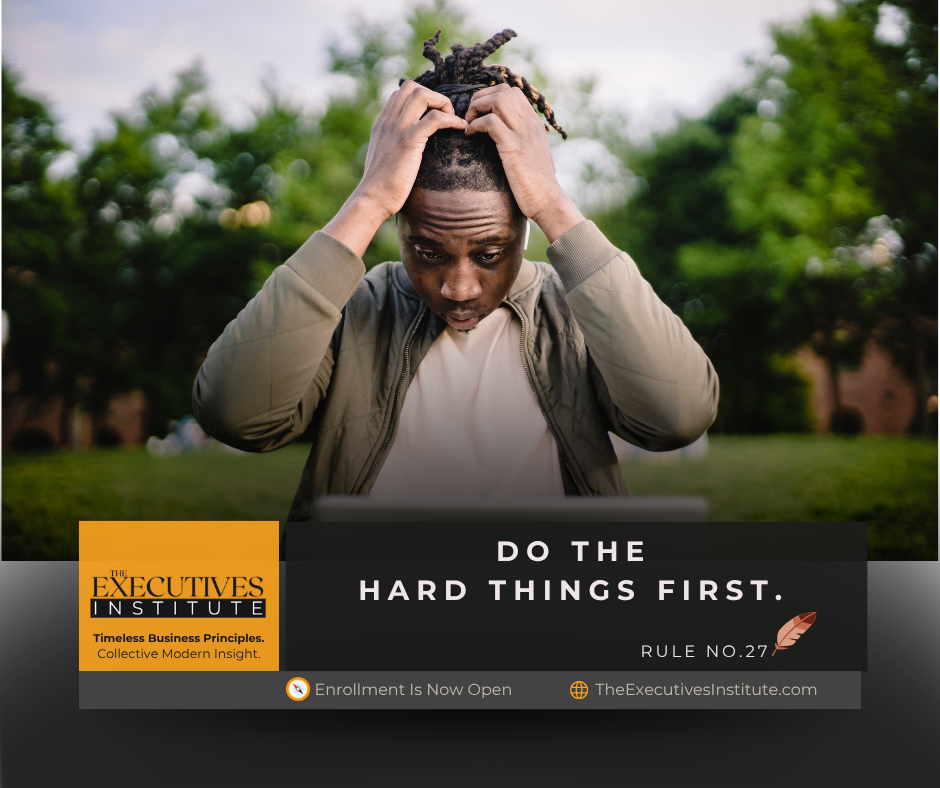
RULE NO. 27 SUMMARY ![]()
The tasks we avoid are often the ones that matter most. “Do the Hard Things First” is a call to discipline—tackle your toughest, highest-impact priorities before everything else. It’s not about doing more, it’s about doing what matters when your mind is sharp, your willpower is high, and your excuses haven’t shown up yet. In leadership and business, procrastination on the hard stuff is procrastination on progress.
RECOMMENDED READING: Eat That Frog by Brian Tracy
Plus, this week’s —
Action Step: Identify your “frog” for the week: List the top 1–3 high-impact tasks you’ve been avoiding. Schedule time first thing each day this week to tackle one of these tasks head-on—no distractions, no delays. Track your progress and note how your focus and momentum shift.
Ask Yourself: Am I starting my day with tasks that matter most, or am I letting urgent but low-value work steal my energy?
WEEK 23 | RULE NO. 28 —Learn by doing.

RULE NO. 28 SUMMARY ![]()
Real mastery doesn’t come from theory alone—it’s forged in action. Learn by Doing means getting your hands dirty, embracing failure as part of the process, and internalizing knowledge through lived experience. The most transformative growth comes when you stop preparing and start practicing under real conditions. This rule is a call to engage directly, iterate quickly, and let action teach you what thinking never could.
RECOMMENDED READING: The Art of Learning by Josh Waitzkin
Plus, this week’s —
Action Step: Take one meaningful action this week that moves a project, idea, or skill forward—without waiting for perfect conditions. Track what you learn from the outcome, including mistakes and unexpected insights. Document one key takeaway that can be applied next week.
Ask Yourself: Where am I holding back from taking action because I’m afraid of imperfection, and what’s the smallest step I can take this week to turn learning into doing?
Chapter 6: Hard Conversations, Hard Decisions
WEEK 24 | RULE NO. 14 —Know when to let go.

RULE NO. 14 SUMMARY ![]()
Good leaders don’t just build — they prune. Knowing when to let go of a person, product, process, or plan is a mark of maturity and strategic clarity. Holding on too long stifles progress. Letting go at the right time creates room for growth, health, and innovation. Endings aren’t failures — they’re often the first step toward something better.
RECOMMENDED READING: Necessary Endings by Dr. Henry Cloud
Plus, this week’s —
Action Step: This week, identify one area in your business, team, or personal leadership where you’re holding on out of habit, comfort, or fear rather than strategic value. Map the costs — financial, operational, and cultural — of keeping it. Decide whether to continue, restructure, or end it by Friday.
Ask Yourself: What am I keeping alive that is actually holding me back — and what would happen if I let it go this week?
Make this Rule —Know when to let go —immediately actionable and force a tangible decision rather than abstract reflection.
WEEK 25 | RULE NO. 19 —Stop doing what doesn’t work.
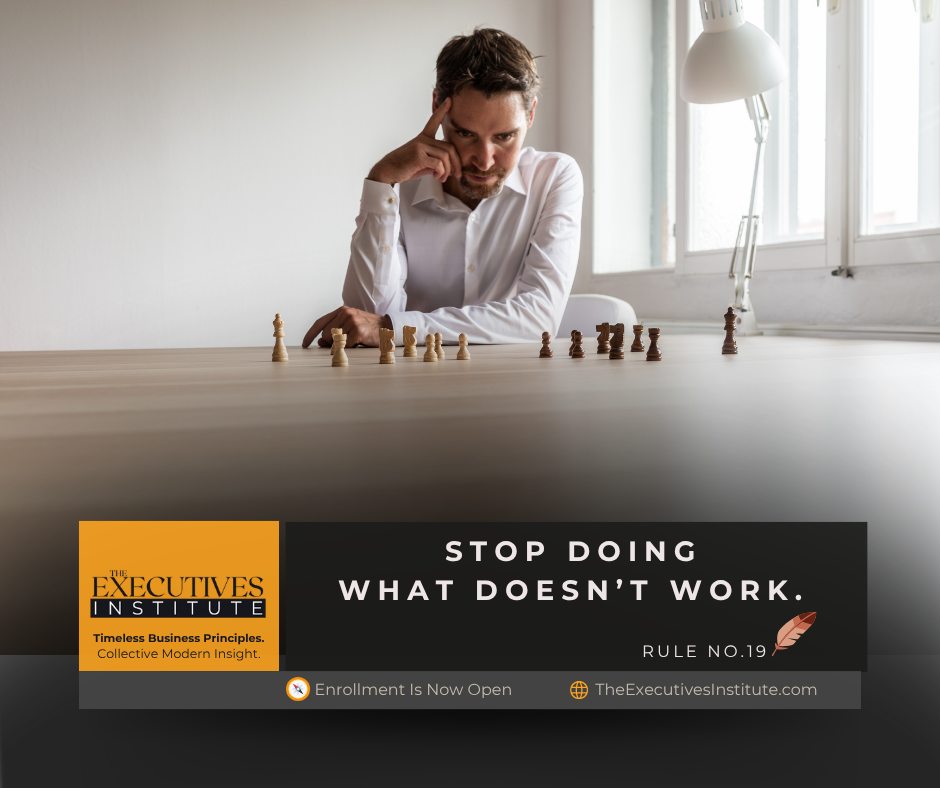
RULE NO. 19 SUMMARY ![]()
Success can become its own trap. The habits, strategies, and mindsets that helped you reach your current level often become blind spots as you aim higher. This rule demands the discipline to let go of outdated behaviors—especially the ones that feel familiar, comfortable, or once-effective. It’s about recognizing that yesterday’s wins may be today’s liabilities. Real growth starts not just by adding new tactics—but by subtracting what no longer serves you or your business.
RECOMMENDED READING: What Got You Here Won’t Get You There by Marshall Goldsmith
Plus, this week’s —
Action Step: Audit and Eliminate One Outdated Habit
- Review your past week and identify one behavior, habit, or process that you continued out of routine or comfort—but that added little or no value.
- Commit to stopping or delegating it for the next week.
- Track the impact: note the time saved, stress reduced, or clarity gained.
Example: If you spend hours in status meetings that rarely move the needle, cancel or delegate one this week and observe the difference.
Ask Yourself: What am I still doing today that worked in the past—but is now holding me back?
WEEK 26 | RULE NO. 42 —Feedback is a gift.

RULE NO. 42 SUMMARY ![]()
Most people say they want feedback—until they actually get it. The truth is, most leaders aren’t wired to receive feedback well, even when they desperately need it. But feedback, when accepted without defensiveness and viewed as fuel—not fire—is a shortcut to growth, clarity, and leadership maturity. Ignore it, and you stay stuck. Embrace it, and you evolve.
RECOMMENDED READING: Thanks for the Feedback by Douglas Stone & Sheila Heen
Plus, this week’s —
Action Step: This week, intentionally seek out one piece of honest feedback from someone you trust—but who isn’t afraid to challenge you. Listen without defending, explaining, or justifying. Take notes, thank them, and identify one concrete adjustment you will make based on what you hear.
Ask Yourself: Am I hearing the truth—or just what’s easy for me to accept? What blind spot might someone be trying to show me that I’ve been ignoring?
WEEK 27 | RULE NO. 50 —If you’re going to eat shit, don’t nibble.
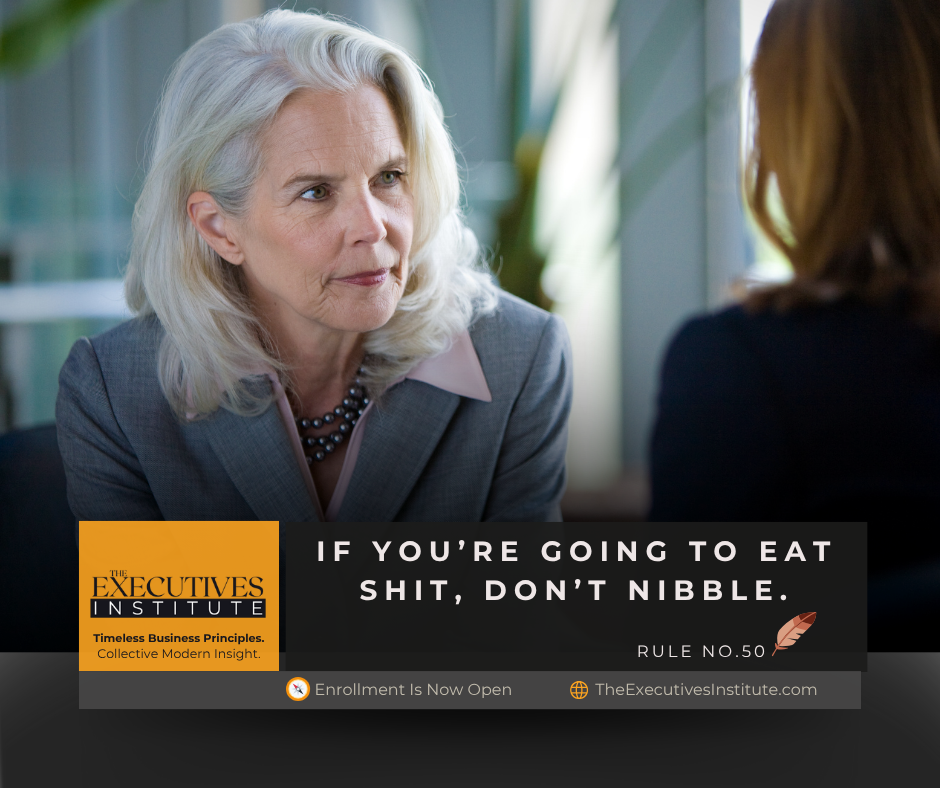
RULE NO. 50 SUMMARY ![]()
When the tough decision is inevitable, stop stalling. Stop dressing it up. Go straight at it. Half-measures just prolong the pain and erode your credibility. In business, you’ll occasionally have to do something unpleasant—fire a friend, shut down a product, take a public hit. Dragging it out or sugarcoating it only makes it worse. Swallow hard, take the full bite, and move on. Fast, direct action beats slow, “polite” decay.
RECOMMENDED READING: The Hard Thing About Hard Things by Ben Horowitz
Plus, this week’s —
Action Step: Identify one difficult decision you’ve been avoiding—something that’s causing stress, uncertainty, or organizational friction. Commit to executing it fully this week. Set a clear deadline, communicate it to those affected, and take the necessary action without hesitation or half-measures. No dithering. No nibbling. Just the full bite.
Ask Yourself: Am I delaying this decision to protect myself or spare others, and what’s the real cost of waiting?
Chapter 7: Systems That Scale
WEEK 28 | RULE NO. 23 —Simplicity scales.
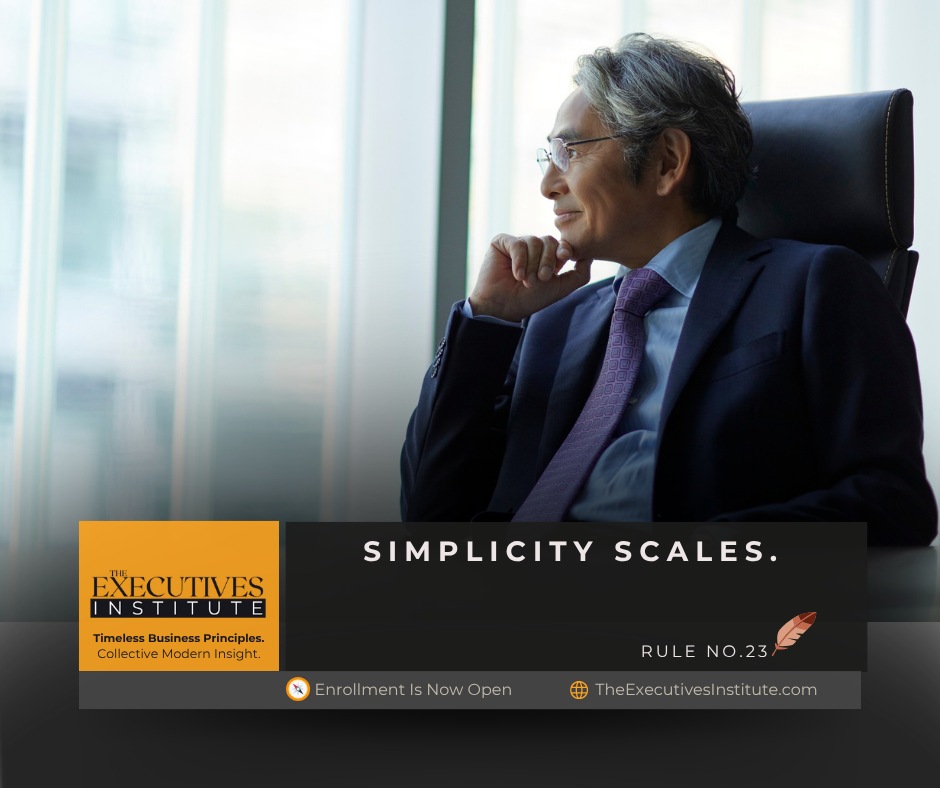
RULE NO. 23 SUMMARY ![]()
Complexity kills execution. Simplicity isn’t just elegant—it’s efficient, repeatable, and scalable. The most effective strategies, decisions, and systems are grounded in a few clear rules that people can understand, remember, and act on. If it takes a whiteboard and a translator to explain, it won’t scale.
RECOMMENDED READING: Simple Rules by Donald Sull & Kathleen Eisenhardt
Plus, this week’s —
Action Step: Identify one process, system, or decision in your business that has more than five steps or rules. Strip it down to the absolute essentials—no fluff, no legacy steps “just because we’ve always done it this way.” Test the simplified version for one week and track what actually improves.
Ask Yourself: Where is complexity quietly slowing us down, and what would happen if we reduced it to its simplest, most effective form?
WEEK 29 | RULE NO. 32 —Don’t scale chaos.

RULE NO. 32 SUMMARY ![]()
Before you scale, get your house in order. Systems beat hustle. Chaos at a small size becomes a catastrophe at scale. Scaling a business with broken processes, unclear accountability, or misaligned culture only multiplies the dysfunction. Growth doesn’t fix chaos — it exposes and magnifies it.
RECOMMENDED READING: Scaling Up by Verne Harnish
Plus, this week’s —
Action Step: Audit one critical system in your business this week. Pick an area where work frequently falls through the cracks — e.g., customer onboarding, project handoffs, or financial reporting. Document the current process, identify the biggest points of failure, and implement one immediate fix that makes it repeatable without depending on a single person.
Ask Yourself: If our company doubled in size tomorrow, would this process hold — or would it implode?
WEEK 30 | RULE NO. 36 —Build a business that runs without you.

RULE NO. 36 SUMMARY![]()
If your business can’t thrive without you, you don’t own a company—you own a job. A self-reliant business is the ultimate test of leadership, systems, and strategic clarity. Whether you’re looking to sell, scale, or simply breathe, building a company that doesn’t depend on you is a sign of maturity, not detachment.
RECOMMENDED READING: Built to Sell by John Warrillow
Plus, this week’s —
Action Step: This week, map out every critical process in your business that still depends on you personally. Identify at least three tasks you can fully delegate, systematize, or automate. Assign accountability, set clear standards, and schedule a review to ensure these tasks are no longer bottlenecks.
Ask Yourself: If I disappeared for 30 days, which parts of my business would stop, slow down, or fail—and what can I do this week to fix that?
WEEK 31 | RULE NO. 33 —Processes protect your time.

RULE NO. 33 SUMMARY ![]()
Systems aren’t bureaucracy—they’re armor. In fast-paced environments where decisions pile up and mistakes cost time, solid processes safeguard your focus. A well-designed checklist isn’t about reducing thought—it’s about removing chaos, catching preventable errors, and freeing your mind for higher-level work. The right process protects what matters most: your attention, your energy, and your time.
RECOMMENDED READING: The Checklist Manifesto by Atul Gawande
Plus, this week’s —
Action Step: Identify one recurring task or decision in your business that consistently drains time, creates errors, or requires constant reminders. Design a simple checklist or step-by-step process for it this week. Implement it, and track whether it saves time, prevents mistakes, or reduces stress. Keep refining until the process works reliably without constant oversight.
Ask Yourself: Which part of my day—or my team’s workflow—is being wasted on preventable errors or repeated explanations?
And, what one small process could I create this week that would protect hours of my time and others’?
Chapter 8: Sales – the Lifeblood
WEEK 32 | RULE NO. 13 —Know your numbers.

RULE NO. 13 SUMMARY ![]()
If you don’t understand the numbers, you don’t understand the business. Knowing your financials isn’t just for accountants—it’s essential for every leader who wants to make smart decisions, allocate resources wisely, and build a business that lasts.
RECOMMENDED READING: Financial Intelligence by Karen Berman & Joe Knight
Plus, this week’s —
Action Step: This week, take 30–60 minutes to pull the three key financial statements for your business: Income Statement, Balance Sheet, and Cash Flow Statement. Review them line by line and identify:
- One metric that surprises you.
- One area where the numbers tell a different story than your intuition.
- One immediate action you can take based on what you learn.
Don’t delegate this—look at the numbers yourself. Understanding them is your responsibility.
Ask Yourself: Which number in my business is most misunderstood, ignored, or misinterpreted—and what would I do differently if I truly understood it?
WEEK 33 | RULE NO. 20 —Cash flow is king.

RULE NO. 20 SUMMARY ![]()
Forget vanity metrics. Forget top-line revenue. If your business doesn’t produce consistent, positive cash flow, it’s not healthy — it’s just temporarily surviving. This rule reminds us that cash is not just a financial metric; it’s the oxygen of a business. You can’t grow, pay your people, or weather a storm without it. Mastering cash flow isn’t an accounting detail — it’s leadership.
RECOMMENDED READING: Simple Numbers, Straight Talk, Big Profits! by Greg Crabtree
Plus, this week’s —
Action Step: Review your cash flow statement this week and identify the top three areas where cash is leaking or could be optimized. Examples include slow-paying clients, excessive inventory, or recurring nonessential expenses. Then, implement one immediate change to protect or accelerate cash — even if it’s small.
Ask Yourself: If all revenue stopped tomorrow, how long could my business operate without compromising employees, vendors, or commitments — and what would I need to change today to extend that runway?
This forces real, practical reflection — not just theoretical accounting.
WEEK 34 | RULE NO. 38 —Build once, sell forever.

RULE NO. 38 SUMMARY ![]()
Most businesses are built on a treadmill—sell, deliver, repeat. This rule flips that model. Instead of chasing the next transaction, you design something once that can be sold repeatedly with minimal friction. It’s about creating scalable value that generates recurring revenue while freeing your time and multiplying your enterprise value. This isn’t theory—it’s the backbone of resilient, modern business models.
RECOMMENDED READING: The Automatic Customer by John Warrillow
Plus, this week’s —
Action Step: Identify one product, service, or process in your business that could be transformed into a recurring or repeatable model. Map out the steps required to make it deliverable automatically—whether through a subscription, membership, licensing, or packaged solution. Commit to taking at least one concrete step this week toward systematizing it.
Ask Yourself: What could I build once this week that will continue to generate value—and revenue—without me showing up every single day?
WEEK 35 | RULE NO. 40 —Sell the vision, not just the product.

RULE NO. 40 SUMMARY ![]()
Don’t just push features — inspire belief. Customers don’t buy what you do; they buy why you do it. Great companies lead with purpose. When you sell the vision behind your product, you attract loyalty, not just transactions. Without a clearly communicated “why,” even the best offerings get lost in the noise.
RECOMMENDED READING: Start with Why by Simon Sinek
Plus, this week’s —
Action Step: Craft your “why statement.” Sit down this week and write a concise, compelling statement that explains why your business exists beyond making money. Share it with your team and ask for feedback — refine it until it resonates clearly and naturally. Then, identify one customer-facing touchpoint (website, pitch, email, or presentation) where you can lead with that “why” instead of your features or specs.
Ask Yourself: Am I selling what we do, or the belief behind what we do?
When a customer walks away, do they understand why we exist — or just what we sell?
Chapter 9: Culture You Can Count On
WEEK 36 | RULE NO. 34 —Great businesses outlive great products.

RULE NO. 34 SUMMARY ![]()
Legendary companies don’t hinge their future on any single product, service, or trend. They endure because they’re built on purpose, values, and systems that outlast market shifts and category obsolescence. While competitors chase what’s hot, enduring businesses invest in what’s timeless: culture, continuity, and core ideology. In other words—your best product should never be your identity. It’s just a chapter, not the whole story.
RECOMMENDED READING: Built to Last by Jim Collins
Plus, this week’s —
Action Step: Review your current product lineup and map each offering to the company’s core purpose and long-term strategy. Identify any product that could disappear tomorrow without threatening the business—and any that could take down the company if it failed. Develop one actionable change to strengthen systems, culture, or processes so the business can thrive independent of any single product.
Ask Yourself: Am I building a business that can survive the loss of today’s best product—or am I building a product that can survive only while it’s hot?
WEEK 37 | RULE NO. 35 —Raise the bar, then raise it again.
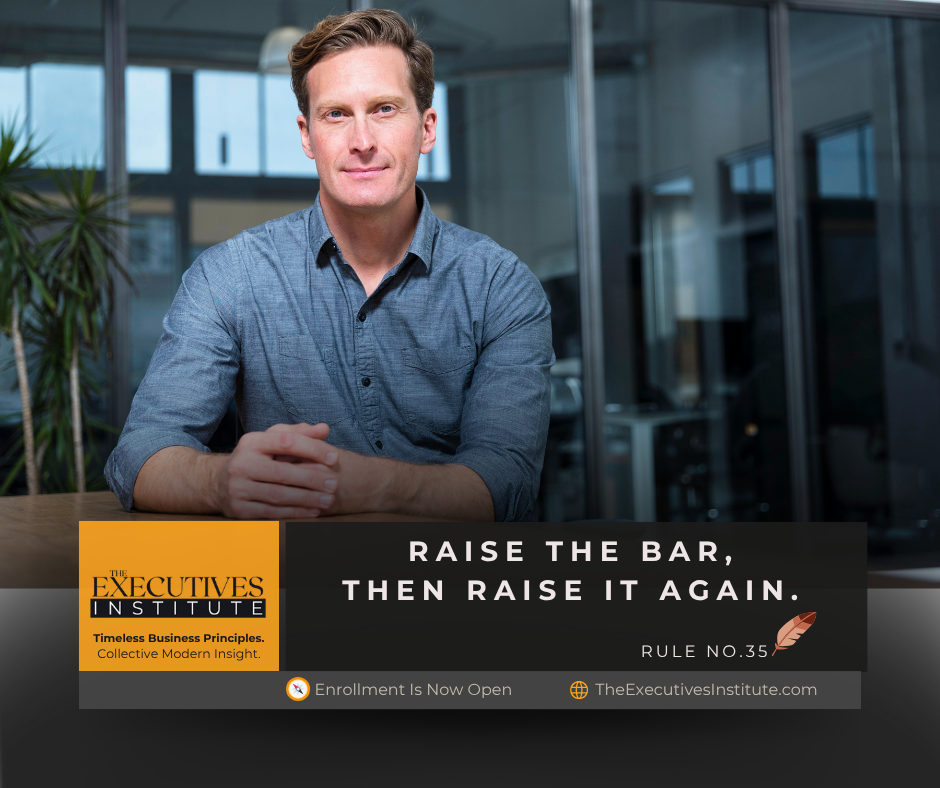
RULE NO. 35 SUMMARY ![]()
Great companies don’t settle. They refuse to be lulled by early wins or fooled by temporary success. They build a culture where good isn’t good enough — and even great becomes the new baseline to surpass. This rule reminds leaders that the bar is never fixed. Raise it, reach it, and then raise it again. Because in enduring businesses, the pursuit of better never ends.
RECOMMENDED READING: Good to Great by Jim Collins
Plus, this week’s —
Action Step: Identify one area of your business where “good” has become acceptable. Then, define a measurable way to raise the standard this week. Assign ownership, set a clear metric, and schedule a check-in to ensure it moves beyond talk into action.
Ask Yourself: What part of my business or team am I tolerating as merely good, when it could be great — and what concrete step can I take this week to raise the bar?
This is SUCH an important Rule, that we’re doubling down on studies this week!
Action Step #2: Pick one key process, product, or team metric that has plateaued. This week, push it beyond its current best — set a bold target, and make someone accountable.
Ask Yourself: Where am I settling for what’s working instead of demanding what’s exceptional?
Action Step #3: Hold a 15-minute team huddle to identify one area where “good enough” is creeping in. Define a clear improvement goal that raises the standard immediately.
Ask Yourself: If a competitor started tomorrow, what part of our business would they outclass first?
Action Step #4: Review last quarter’s results and highlight one achievement that felt like a win. Ask, “Can we do better?” Then implement one concrete improvement this week.
Ask Yourself: Am I celebrating success or masking mediocrity?
WEEK 38 | RULE NO. 46 —Don’t outgrow your values.

RULE NO. 46 SUMMARY ![]()
Growth is good. Scale is exciting. But when an organization gets bigger, faster, or more successful, the first casualty is often its core values. What was once instinctive becomes negotiable. This rule is your reminder that values aren’t a phase — they’re your foundation. Ignore them at your peril.
RECOMMENDED READING: The Advantage by Patrick Lencioni
Plus, this week’s —
Action Step: Review one recent decision or initiative from the past week. Ask: Did this action align with our core values, or did we compromise for convenience, speed, or growth? Document your findings and discuss them with your leadership team. Identify at least one concrete step to reinforce your values in the coming week.
Ask Yourself: Where in the last seven days did I bend our values—and what will I do to correct it?
Chapter 10: Leadership That Lasts
WEEK 39 | RULE NO. 16 —Time is your most precious asset.

RULE NO. 16 SUMMARY![]()
Time is the only resource you can’t earn back. Money can be recovered. Opportunities can be replaced. But once time is gone, it’s gone. This rule reminds executives that how they spend their time is how they lead. Protecting it, structuring it, and aligning it with your highest priorities is not optional — it’s foundational. Those who fail to guard their time are not running their business. Their business is running them.
RECOMMENDED READING: The Time Trap by Alec Mackenzie
Plus, this week’s —
Action Step: This week, conduct a calendar audit. Review every meeting, recurring task, and “urgent” activity on your schedule. Identify at least one commitment that does not directly contribute to your highest priorities and either delegate, reschedule, or eliminate it.
Ask Yourself: Am I spending my time on activities that move the business forward — or am I reacting to the urgencies of others?
WEEK 40 | RULE NO. 17 —Speed Matters.

RULE NO. 17 SUMMARY ![]()
Speed beats perfection when it comes to momentum, innovation, and decision-making. In a world where hesitation is often more dangerous than error, moving quickly allows you to test, adapt, and improve in real time. Most breakthroughs don’t come from overthinking — they come from action. The leaders who win are the ones who out-learn and out-adjust, not just out-plan. When in doubt, make a move. You can correct course faster than you can create a flawless plan.
RECOMMENDED READING: Fail Fast, Fail Often by Ryan Babineaux & John Krumboltz
Plus, this week’s —
Action Step: This week, identify one decision or project you’ve been delaying in search of the “perfect” approach. Set a firm 48-hour deadline to take tangible action — even if it’s small — and commit to adjusting as you go. Track what you learn from the move and how quickly you can iterate.
Ask Yourself: Am I moving fast enough to learn, adapt, and stay ahead — or am I letting the pursuit of perfection slow me down?
WEEK 41 | RULE NO. 29 —Protect your downside.

RULE NO. 29 SUMMARY![]()
Great investors and business leaders don’t just chase upside — they prepare for the downside. They understand that losses are more damaging than missed opportunities. Protecting your downside means preserving capital, limiting exposure, and designing strategies that survive worst-case scenarios. It’s not fear — it’s discipline. It’s playing defense before going on offense.
RECOMMENED READING: Rich Dad’s Guide to Investing by Robert Kiyosaki
Plus, this week’s —
Action Step: Identify your top three potential downside risks this week and design a protective action for each.
Example: If launching a new product, run a “worst-case financial scenario” to see how it impacts cash flow.
Example: If one client represents 40% of revenue, create a contingency plan or diversify your client base.
Ask Yourself: What could happen this week that would set us back the most — and what am I doing right now to make sure it doesn’t?
WEEK 42 | RULE NO. 39 —Your network is your net worth.

RULE NO. 39 SUMMARY ![]()
Your success is tied to the strength and depth of your relationships. No matter how sharp your skills or solid your product, if you’re not connected to the right people, you’re playing small. Business still runs on trust—and trust is built through connection. The most valuable currency in business? Who will take your call.
RECOMMENDED READING: Never Eat Alone by Keith Ferrazzi
Plus, this week’s —
Action Step: Reach out to three people this week—not for favors, not for deals, but to genuinely connect. It could be a colleague you admire, a past mentor, or someone you’ve been meaning to get to know. Offer insight, gratitude, or just a check-in. Track the responses and reflect on the quality of these connections, not the quantity.
Ask Yourself: Who in my network have I truly invested in this quarter?
Which relationships am I neglecting that could accelerate my business growth or theirs?
Am I giving value first, or only reaching out when I need something?
Chapter 11: Avoiding the Common Pitfalls
WEEK 43 | RULE NO. 30 —Profit is not a dirty word.

RULE NO. 30 SUMMARY ![]()
Profit isn’t a reward you hope for at year-end—it’s a discipline you practice from day one. In too many businesses, “profit” is treated like a dirty word—something to downplay, hide, or sacrifice in the name of growth. But no matter how noble your mission, if your business isn’t sustainably profitable, it won’t last. Profit is not greed—it’s oxygen. Prioritize it. Protect it. Bake it into your system, not just your spreadsheet.
RECOMMENDED READING: Profit First by Mike Michalowicz
Plus, this week’s —
Action Step: Allocate Profit First: Review your current cash flow and implement a simple “profit first” system this week. Set aside a fixed percentage of every incoming dollar into a dedicated profit account before paying any expenses. Treat this like a non-negotiable bill—profit comes first, everything else adjusts around it.
Ask Yourself: Am I treating profit as an afterthought, or am I forcing my business to generate it intentionally every day?
WEEK 44 | RULE NO. 47 —The bottleneck is at the top.

RULE NO. 47 SUMMARY ![]()
When a team is underperforming, the root cause usually isn’t “down there.” It’s at the top. Culture, clarity, accountability—these flow from leadership. If something’s stuck, stalled, or sideways, odds are high that the real issue starts with the leader. Not the team. Not the market. You.
Strong leadership fixes dysfunction. Weak leadership fuels it.
RECOMMENDED READING: The Five Dysfunctions of a Team by Patrick Lencioni
Plus, this week’s —
Action Step: This week, identify one recurring problem in your team or organization that keeps surfacing. Trace it up the chain—what part of your own leadership is contributing to it? Then take one concrete action to address it directly, whether it’s clarifying expectations, confronting a difficult conversation, or removing a process bottleneck you’ve allowed to persist.
Ask Yourself: Am I part of the problem I’m blaming on others? What one leadership habit can I change this week to unblock my team and improve results?
WEEK 45 | RULE NO. 41 —Reputation compounds.
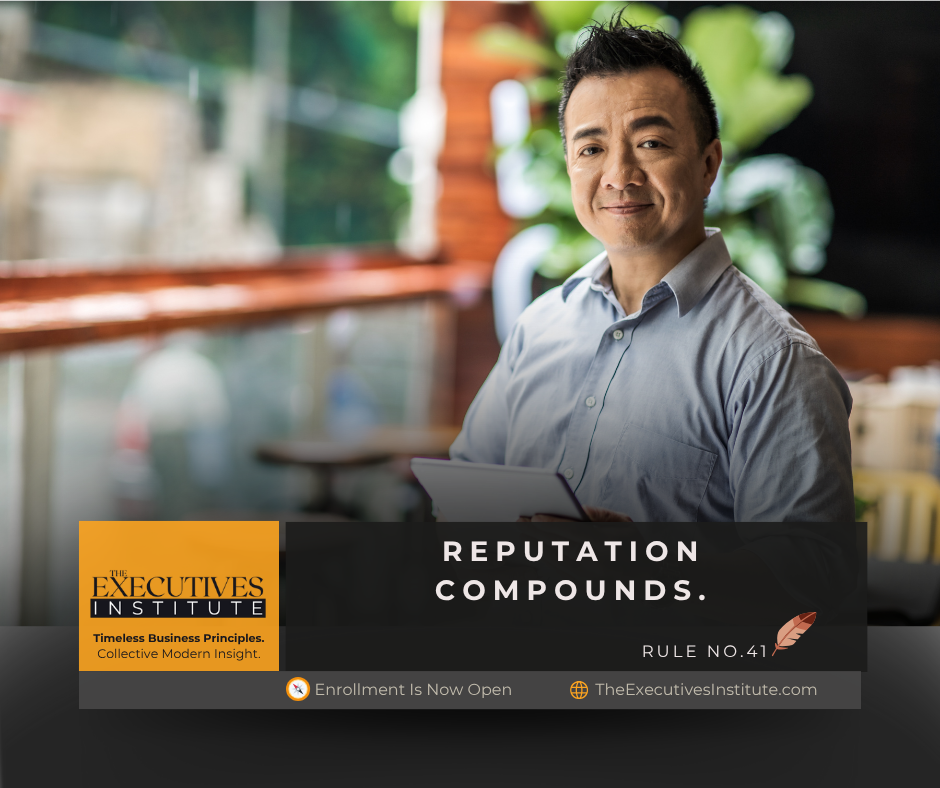
RULE NO. 41 SUMMARY ![]()
In business, reputation is rarely built in big leaps—it’s forged in small, consistent moments of credibility, integrity, and delivery. Like interest on capital, your reputation accrues or erodes over time based on the decisions you make, the relationships you honor, and the problems you either solve or ignore. Today’s digital transparency amplifies everything—good and bad. If you’re not actively building your reputation, you’re leaving it to chance.
RECOMMENDED READING: The Reputation Economy by Michael Fertik
Plus, this week’s —
Action Step: Audit Your Footprint: This week, list every public touchpoint your company and leadership team have—social media profiles, press mentions, client reviews, LinkedIn posts, website messaging, and even customer service interactions. Identify where your reputation is strong, where it’s neutral, and where it could be actively harming trust. Take one tangible action to improve the weakest point.
Ask Yourself: If someone judged my leadership based solely on what they could find online this week, would they trust me—and would I be proud of it?
WEEK 46 | RULE NO. 44 —Own your edge.

RULE NO. 44 SUMMARY ![]()
The marketplace is flooded with average. If you’re not remarkable, you’re invisible. Own Your Edge means knowing exactly what sets you apart—and leaning into it with confidence, clarity, and consistency. Your edge isn’t a liability. It’s your leverage.
RECOMMENDED READING: Purple Cow by Seth Godin
Plus, this week’s —
Action Step: Identify and showcase your edge.
This week, gather your leadership team and pinpoint the one thing your business does better—or differently—than anyone else. Then, take one tangible action to make it more visible to your customers. It could be a marketing tweak, a product feature highlight, or a bold statement in your communications that screams, “This is why we’re different.”
Ask Yourself: Am I hiding our edge—or amplifying it?
Every decision you make this week, from messaging to operations, should pass this test. If it softens or dilutes what makes you remarkable, course-correct immediately. Your edge is your leverage; protect it and let it shine.
Chapter 12: Reflection and Recommittment
WEEK 47 | RULE NO. 37 —Build trust before selling.

RULE NO. 37 SUMMARY ![]()
Trust isn’t a “soft” value—it’s a hard business asset. Selling without trust is like planting seed in concrete: no matter how good your pitch is, it won’t grow. When trust is high, decisions happen faster, friction drops, and influence increases. When it’s absent, suspicion rises and every deal drags or dies.
This rule reminds us that in any meaningful transaction—whether with customers, employees, or partners—trust must be earned before it can be leveraged.
RECOMMENDED READING: The Speed of Trust by Stephen M.R. Covey
Plus, this week’s —
Action Step: This week, identify one client, prospect, or internal stakeholder where trust isn’t fully established. Take a concrete step to earn it—share relevant insights, follow through on a promise, or provide value before asking for anything in return. Track the outcome and reflect on what worked.
Ask Yourself: Am I leading with value and credibility first, or am I asking for a commitment before trust is truly earned?
WEEK 48 | RULE NO. 43 —Run your race.

RULE NO. 43 SUMMARY ![]()
Don’t waste energy trying to beat someone else at their game. Your greatest competition isn’t the business next door — it’s your own untapped potential. Discipline, endurance, and grit win in the long run, not comparison. Run your race. Fully. Relentlessly. On your terms.
RECOMMENDED READING: Can’t Hurt Me by David Goggins
Plus, this week’s —
Action Step: Identify one area where you’ve been unconsciously racing someone else. For the next week, pause and remove any decisions, actions, or metrics that are based on comparison. Replace them with a single, focused action that advances your own objectives. Track your progress privately and note the difference in clarity, energy, and momentum.
Ask Yourself: Am I running my race—or someone else’s?
WEEK 49 | RULE NO. 45 —Protect your mental bandwidth.

RULE NO. 45 SUMMARY ![]()
Your time isn’t your most valuable asset—your focus is. In an economy dominated by distractions and shallow work, the ability to consistently carve out deep, uninterrupted thinking time is a superpower. If you’re constantly switching contexts, reacting to every notification, or multitasking under the illusion of productivity, you’re bleeding cognitive energy. Protecting your mental bandwidth is not a luxury—it’s a discipline.
RECOMMENDED READING: Deep Work by Cal Newport
Plus, this week’s —
Action Step: Block 90 minutes of uninterrupted deep work each day this week. Turn off notifications, close email, silence your phone, and commit fully to one high-impact task that moves your business forward. At the end of each session, jot down what you accomplished and how it felt to work without distraction.
Ask Yourself: What is one recurring distraction I can eliminate this week to reclaim mental clarity?
Reflect honestly. It could be a meeting, a habitual app check, or even a conversation that adds noise without value. The point isn’t busywork—it’s creating space to think, decide, and lead.
WEEK 50 | RULE NO. 48 —Give more than you take.

RULE NO. 48 SUMMARY ![]()
In a world obsessed with getting ahead, the most successful leaders and businesses flip the script. They give—value, time, insight, connection—first and consistently. Not as a tactic, but as a principle. Because when your reputation is built on contribution, trust follows. And trust drives everything.
Give more than you take. Always.
RECOMMENDED READING: The Go-Giver by Bob Burg & John David Mann
RECOMMENDED READING: Deep Work by Cal Newport
Plus, this week’s —
Action Step: Identify one person—client, colleague, or team member—who expects nothing from you, and intentionally give them something of real value this week. It could be insight, time, a connection, or support that moves them forward. Document it: who you helped, what you gave, and the impact it had.
Ask Yourself: Am I creating more value than I am extracting this week?
“Lead with value, not expectation—give more than you take, and watch trust become your currency.”
“Generosity isn’t weakness—it’s leverage. Give more than you take.”
“The fastest way to win loyalty? Deliver more value than anyone expects.”
“When you give first, opportunity follows. Make contribution your strategy.”
“Give without strings. Serve without expectation. Succeed without compromise.”
“Stop counting what you get—start measuring what you give. That’s how leaders rise.”
Congratulations — You Made It!
You’ve completed all 50 weeks of The Weekly Edge. That’s 50 rules, 50 lessons, 50 opportunities to sharpen your thinking and improve your business—one week at a time. Take a moment to recognize the discipline, consistency, and curiosity that brought you here.
But completion doesn’t mean the journey ends. Revisit any rule whenever it’s relevant, refresh your perspective, and apply the principles to new challenges. Great leaders know that true learning is cyclical, not linear.
If you haven’t joined The Executives’ Institute yet, now’s the perfect time. For just $100 per year, you’ll gain access to insights from other business leaders, add your own experience to any rule, and dive deeper into the timeless principles that drive results. You can also participate in our private conversation in the LinkedIn group, sharing lessons, questions, and discoveries with peers who understand the stakes you face. Sign up today
Want to go even further? Consider joining a local CEO Study Group already running the Institute’s 12-chapter, 12-month Start to Scale program—or create your own in your community. Working alongside other leaders accelerates growth, sharpens judgment, and keeps accountability alive.
And this is just the beginning. The next 50 rules—numbers 51 through 100—are already in the works. More insights, more action, more opportunities to elevate your business and your leadership.
Congratulations again.
Stay disciplined, stay curious, and keep building the business and life you want to lead.

